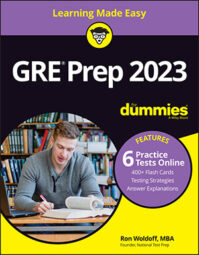Being familiar with the question formats for the Reading Comprehension section helps you field the questions more confidently, because you know what to expect. The GRE presents each question in one of the following three formats:
- Multiple-choice: Choose one answer.
- Multiple-choice: Select all correct answers.
- Sentence-selection: Choose a sentence from the passage.
Anaphylaxis resulting in death is relatively uncommon among children and young adults, because their cardiovascular systems are so resilient. This does not mean, however, that younger people are immune to severe anaphylaxis. Anaphylaxis in younger people typically results in breathing difficulty — a constricted or blocked airway that causes a fatal or near fatal reaction.
Multiple-choice questions: Choose one answer
The following format is the traditional multiple-choice question. You get five answers to choose from, and only one is correct.Based on the passage, how common is anaphylaxis that results in death in children and young adults?
- Very common
- Relatively uncommon
- Practically nonexistent
- In theory only
- Not stated in the passage
Multiple-choice questions: Choose one or more answers
The next question format is a spin on the traditional multiple-choice question. Three choices follow the question, and one, two, or all three of them are correct. You must pick all of the correct choices and no incorrect choices to receive credit for your answer. You don’t receive partial credit for picking only some of the correct answers. The GRE treats a partially answered question as a wrong answer.When anaphylaxis occurs in a child or young adult, what happens? Consider each of the three choices separately and select all that apply.
- Breathing difficulty
- Blocked airway
- Result of a bee sting
You can quickly tell whether to select only one answer or more than one answer by looking at the instruction that accompanies the question: The GRE always instructs you to choose either one or all answers that apply. Also, the selection bubbles near the answer choices are ovals to select one answer or squares to select multiple answers.
Sentence-selection questions: Choose a sentence from the passage
In sentence-selection questions, the GRE presents a description or question followed by instructions to click the sentence in the passage that most closely matches the description or answers the question. Clicking any part of the sentence selects the entire sentence.Choose the sentence in the passage that parents of young children are likely to find most reassuring.In the passage, you click the answer sentence, and it highlights on the screen, like this:

The other sentences in the passage may not be so reassuring to parents of young children.
Strategies for success on the Reading Comprehension questions
Reading Comprehension questions on the GRE test can be the most time-consuming questions of the Verbal section. The best way to ace these questions is to master and use strategies for quickly reading the passages, identifying key facts called for in the questions, and drawing inferences based on subtle implications. Ask yourself the purpose of the passage — why is the author writing this? The following sections explain four useful strategies for effectively and efficiently arriving at the correct answers (and avoiding incorrect answers).The best way to master reading comprehension — meaning you can read the passage quickly and understand it on all its levels — is through practice. Make these graduate-level paragraphs something you read before breakfast, not something you force yourself through every few weeks. They don’t have to be GRE examples, but mobile clips from Instagram and LinkedIn don’t bring your reading skills up to par. Instead, read The Economist, Financial Times, or any number of intellectual publications on a topic you’re interested in, maybe even in your field of study.
Use the context as your road map
Read the passage lightly and get a general idea of where the key information is and what is going on in the passage. This helps you figure out where to find the information as you begin to answer questions.Don’t sweat the details (yet). After reading a question, you can quickly revisit the passage to locate the details for answering the question correctly.
Usually the first paragraph or sentence and/or the last paragraph or sentence tells you what the passage is about (the main idea). The rest of the passage supports or develops this idea. As you read each body paragraph, pay attention to its purpose and how it supports the main idea. This is a key strategy to understanding the passage, and it becomes almost a habit with practice.
Sometimes the entire passage is one giant paragraph. Don’t let that deter you from using this strategy. Look for where one idea ends and another begins and treat that as where the paragraphs should be separated. This can help you map the details as you would for a passage that is actually in separate paragraphs.

